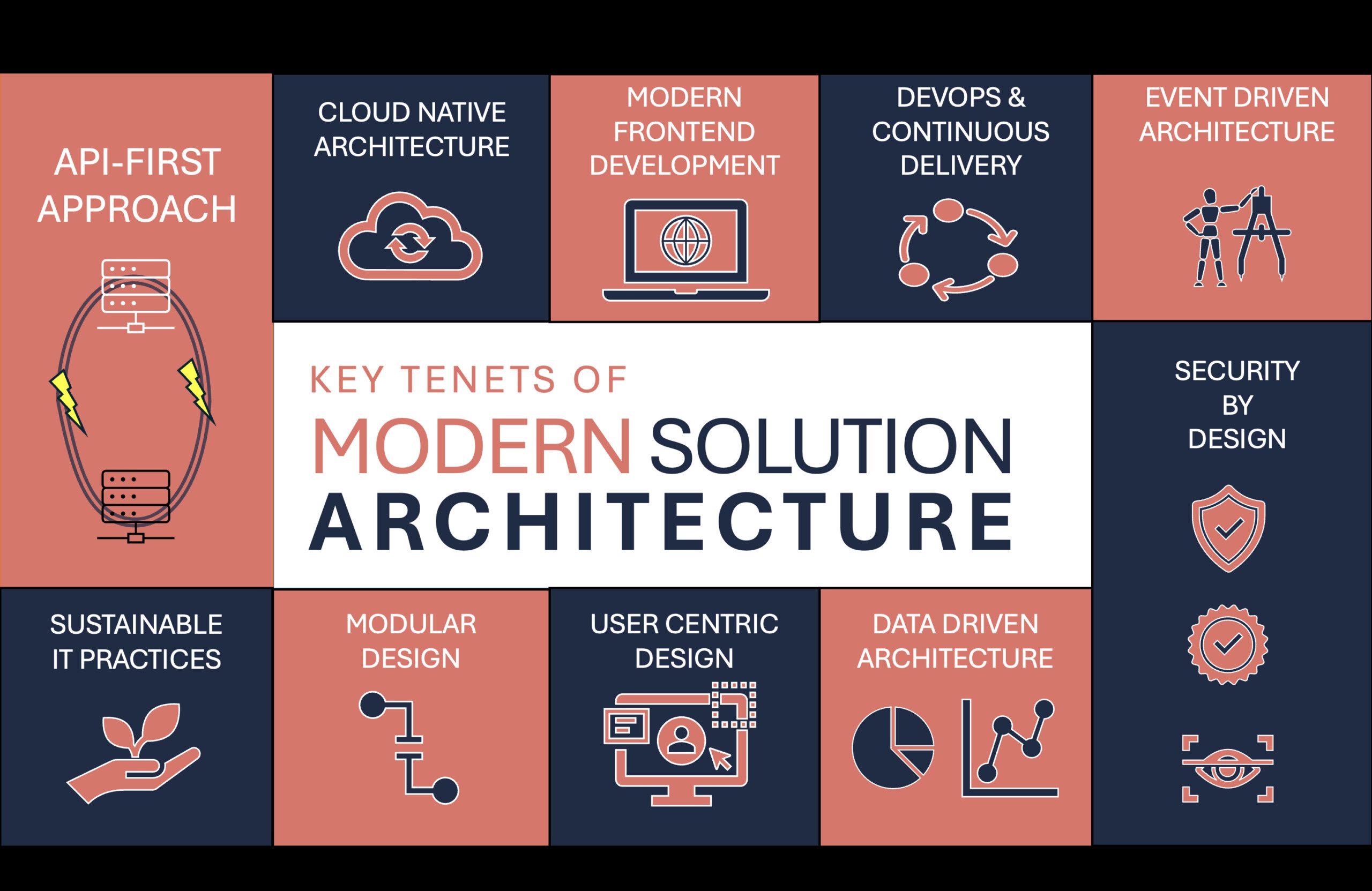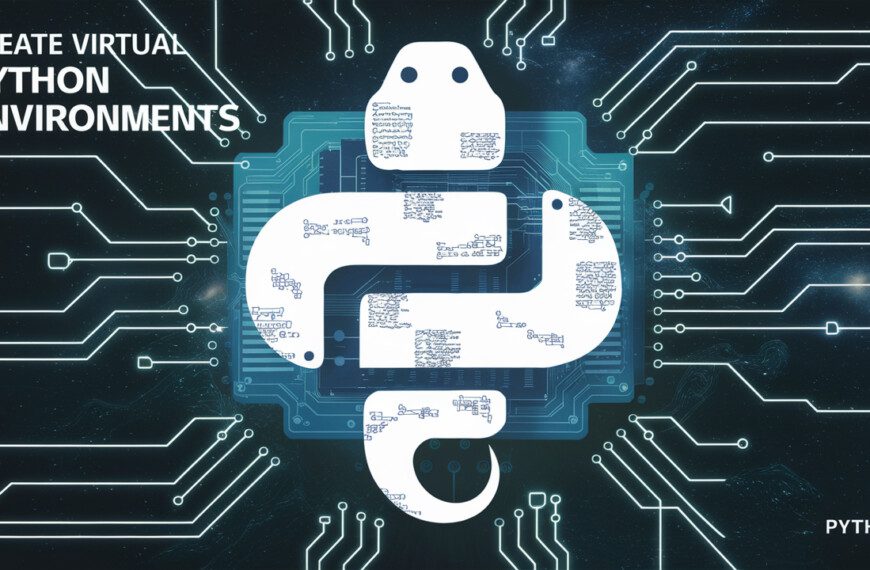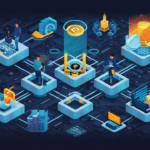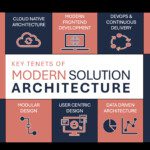What are the latest trends and best practices for defining a solution architecture for a modern application or software system? This is a question that has always bugged me. How can I always keep myself updated? What should be the tenets of a Modern Solution Architecture? I am sure whether you are seasoned Architect or budding one, this very question presents itself to you as well while drafting a solution architecture. Let this blog be your guide or an anchor that keeps you steady by providing you key tenets of a modern solution architecture design.
Modern solution architecture encompasses a set of principles or tenets that guide the design, development, and deployment of software systems. These tenets of modern solution architecture emphasize principles and approaches that align with current technological trends and best practices to ensure that solutions are scalable, maintainable, and future-proof.
Accordingly, I’ll cover the tenet, its objective and principles that should be followed. Below are the key tenets of modern solution architecture:
1. API-First Approach
Objective: Prioritize the development of APIs to ensure interoperability and decoupling of services.
Principles:
- Design APIs Early: Define and design APIs before developing other components.
- Consistency: Ensure consistent API design with standardized formats and protocols (e.g., REST, GraphQL).
- Documentation: Provide comprehensive and easily accessible API documentation.
- Versioning: Implement API versioning to manage changes and maintain backward compatibility.
2. Cloud-Native Architecture
Objective: Leverage cloud services and principles to build scalable and resilient applications.
Principles:
- Microservices: Decompose applications into small, loosely coupled services that can be developed, deployed, and scaled independently.
- Containerization: Use containers (e.g., Docker) to ensure consistent environments across development, testing, and production.
- Orchestration: Utilize orchestration tools (e.g., Kubernetes) to manage containerized applications.
- Serverless Computing: Adopt serverless architectures (e.g., AWS Lambda) for event-driven and scalable solutions.
3. Modern Frontend Development
Objective: Use contemporary frameworks and practices to create responsive and dynamic user interfaces.
Principles:
- Single Page Applications (SPA): Develop SPAs using frameworks like React, Angular, or Vue.js for a seamless user experience.
- Progressive Web Apps (PWA): Build PWAs to provide native app-like experiences on the web.
- Component-Based Architecture: Employ reusable and modular components for consistency and maintainability.
- Responsive Design: Ensure applications are responsive and perform well on various devices and screen sizes.
4. DevOps and Continuous Delivery
Objective: Integrate development and operations to streamline delivery and improve collaboration.
Principles:
- CI/CD Pipelines: Implement Continuous Integration and Continuous Deployment pipelines to automate testing and deployment.
- Infrastructure as Code (IaC): Use IaC tools (e.g., Terraform, AWS CloudFormation) to manage and provision infrastructure.
- Automated Testing: Incorporate automated testing (unit, integration, end-to-end) to ensure code quality and reliability.
- Monitoring and Logging: Implement comprehensive monitoring and logging to gain insights into application performance and issues.
5. Event-Driven Architecture
Objective: Build systems that react to events in real-time for improved responsiveness and scalability.
Principles:
- Event Sourcing: Use event sourcing to capture all changes to the state of an application as a sequence of events.
- Message Brokers: Employ message brokers (e.g., Kafka, RabbitMQ) to handle event distribution and processing.
- Asynchronous Communication: Favor asynchronous communication to decouple services and improve system resilience.
6. Security by Design
Objective: Integrate security considerations into every phase of the software development lifecycle.
Principles:
- Shift Left: Incorporate security testing early in the development process.
- Authentication and Authorization: Implement robust authentication (e.g., OAuth, JWT) and fine-grained authorization mechanisms.
- Data Encryption: Ensure data is encrypted both in transit and at rest.
- Security Best Practices: Follow security best practices and compliance requirements (e.g., OWASP, GDPR).
7. Data-Driven Architecture
Objective: Design systems that leverage data for insights, decision-making, and enhanced functionality.
Principles:
- Data Lakes and Warehouses: Use data lakes and warehouses to store and manage large volumes of structured and unstructured data.
- Analytics and BI: Integrate analytics and business intelligence tools to gain insights from data.
- Machine Learning: Incorporate machine learning models to enhance capabilities and provide predictive insights.
- Real-Time Data Processing: Utilize real-time data processing frameworks (e.g., Apache Flink, Apache Storm) for immediate insights.
8. Modular and Extensible Design
Objective: Ensure the architecture is flexible and can easily adapt to future requirements.
Principles:
- Plugin Architecture: Design with a plugin architecture to allow easy addition of new features without major changes.
- Modularity: Keep components modular and loosely coupled to facilitate independent development and updates.
- API Extensibility: Design APIs to be easily extendable for future enhancements.
9. User-Centered Design
Objective: Prioritize user experience and usability in the design and development process.
Principles:
- User Research: Conduct user research to understand needs, behaviors, and pain points.
- Usability Testing: Perform usability testing to validate designs and ensure ease of use.
- Iterative Design: Employ an iterative design process to continuously improve the user experience.
10. Sustainability and Cost Efficiency
Objective: Design systems that are environmentally and economically sustainable.
Principles:
- Efficient Resource Utilization: Optimize resource usage to minimize costs and environmental impact.
- Green IT Practices: Follow green IT practices, such as energy-efficient hardware and data center optimization.
- Cost Monitoring: Continuously monitor and optimize operational costs.
Disclaimer & An Important Note:
I have compiled these trends through my research into the latest industry practices and by collaborating with seasoned solution architects who deliver solutions to enterprises worldwide. While I didn’t originate these trends, I’ve synthesized them from my findings. If there are any additional trends you feel I overlooked, please share your insights in the comments. I’m eager to continue learning and evolving, as this process is ongoing, and these principles are constantly evolving.
Furthermore, it’s essential to consider not only the solution requirements but also the unique needs of the customer, encompassing factors such as their size, scale, cost considerations, and efficiency requirements, before implementing these principles.











